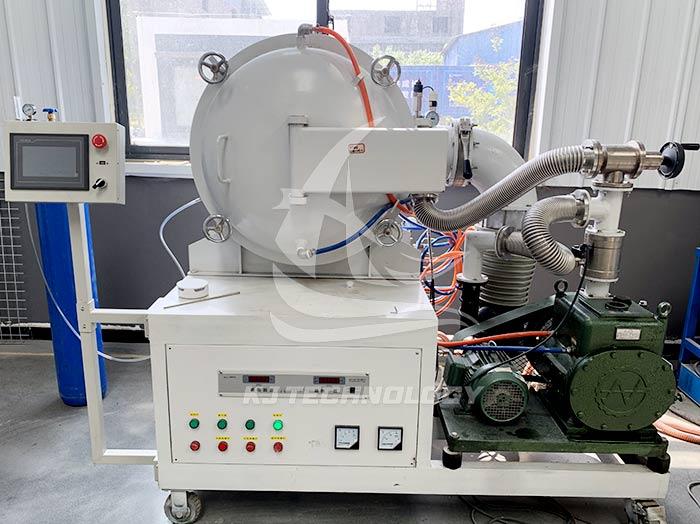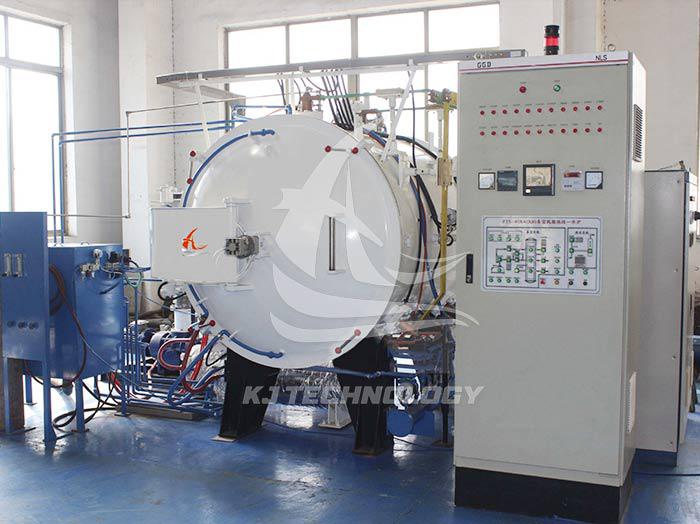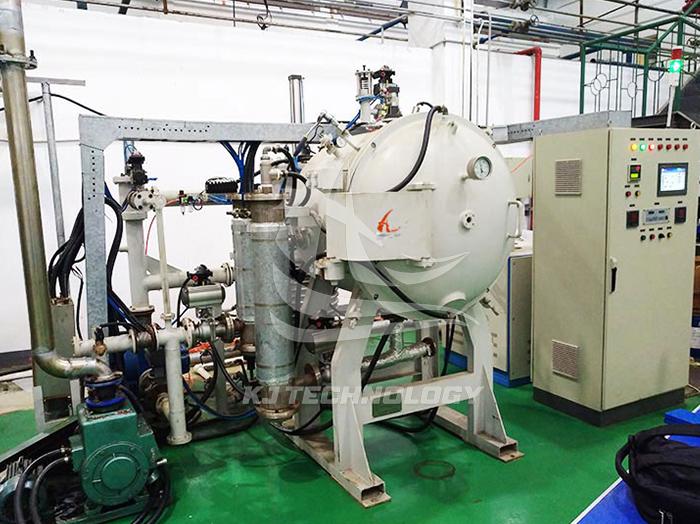Working principle of vertical graphite carbon tube vacuum furnace
 10-17-2025 Author: KJ technology
10-17-2025 Author: KJ technology
The vertical graphite carbon tube vacuum furnace is a high-end heat treatment equipment that integrates high-temperature heating, vacuum environment control, and precision process support. Its working principle is achieved through the synergy of four core links: heat source generation, vacuum environment construction, temperature control, and process execution. Here is a detailed analysis:
1. Heat source generation: graphite carbon tube resistance heating
Characteristics of graphite carbon nanotubes
Graphite carbon tubes are made of high-purity graphite, which has high electrical resistivity and excellent thermal conductivity. They can generate a large amount of heat through the resistance effect when powered on.
Graphite carbon nanotubes are resistant to high temperatures (up to 2300 ℃) and have strong chemical stability. They are not easily oxidized or volatilized in vacuum or inert atmospheres.
heating process
When current passes through graphite carbon nanotubes, the electrons inside the nanotubes collide with the lattice to generate Joule heat, which is uniformly transferred to the working area inside the furnace through thermal conduction.
The graphite carbon tube and electrode are connected by cylindrical contact, with one end of the electrode energized and the other end allowed to expand freely to avoid poor contact or carbon tube fracture caused by thermal stress.
2. Vacuum environment construction: multi-stage pump system and sealing design
Composition of vacuum system
Mechanical pump (such as 2X-30 mechanical pump): As a front-end pump, it pumps the pressure inside the furnace from atmospheric pressure to the level of 10 ⁻¹ Pa.
Molecular pump/Roots pump/diffusion pump: As a secondary pump, it further pumps pressure to ultra-low vacuum levels.
Vacuum gauge: Real time monitoring of furnace pressure to ensure that the process is carried out at the specified vacuum level.
Sealing and insulation design
Furnace structure: Adopting a vertical double-layer shell design, the outer layer is water-cooled carbon steel, and the inner layer is made of stainless steel or high-purity alumina fiber. The furnace shell is cooled by circulating water to prevent overheating and deformation.
Sealing method: The furnace cover and furnace body are sealed with metal sealing rings or rubber O-rings, and gas inlet and outlet are controlled by vacuum valves (such as gate valves and plug valves).
Thermal insulation device: Multiple layers of graphite composite carbon felt or radiation screen form a thermal insulation layer to reduce heat loss and improve energy efficiency.
3. Temperature control: PID regulation and multi-mode temperature measurement
Temperature control system
PID controller: Accurately adjust heating power through proportional integral derivative algorithm to achieve temperature stability control.
Programmed temperature control: supports multiple temperature rise curve settings to adapt to different material processing requirements.
Temperature measurement method
Thermocouple temperature measurement: The tungsten rhenium thermocouple (WRe5/26) is used for temperature measurement below 1500 ℃, with fast response and high accuracy.
Infrared thermometer: used for measuring high temperatures above 1500 ℃, non-contact temperature measurement to avoid thermocouple contamination or damage.
Dual mode switching: The system automatically switches temperature measurement modes to ensure full temperature range accuracy.
4. Process Execution: Vacuum/Atmosphere Control and Material Handling
Vacuum process
Material purification: Heating materials in a vacuum environment to remove volatile impurities (such as hydrogen and oxygen) and improve material purity.
Anti oxidation treatment: Avoid metal or ceramic materials from reacting with oxygen at high temperatures to maintain surface smoothness.
Inert atmosphere process
Gas injection: The flow rate of inert gases such as argon (Ar) and nitrogen (N ₂) is precisely controlled by a mass flow meter to create a protective atmosphere.
Active atmosphere process: Some equipment supports the introduction of hydrogen (H ₂) or methane (CH ₄) for reduction reactions or carbon deposition.
Material handling process
Loading: Open the furnace cover, place the material into a graphite crucible or tray, close the furnace cover and seal it.
Vacuum pumping: Start the mechanical pump and molecular pump to pump the furnace pressure to the required process value.
Heating: Start the heating system and raise the temperature to the target temperature according to the preset program.
Insulation and cooling: Maintain at the target temperature for a period of time (insulation), and then cool to room temperature at a controlled rate.
Material retrieval: After breaking the vacuum, open the furnace cover and retrieve the processed material.
5. Key technological advantages
Efficient and energy-saving: Graphite carbon tubes have excellent thermal conductivity, minimal heat loss, and can be used in a vacuum environment to reduce heat dissipation.
High temperature uniformity: The design of insulation and radiation screens reduces thermal radiation interference, and the temperature uniformity can reach within ± 5 ℃.
Material purity guarantee: The vacuum environment prevents material oxidation, volatilization, or contamination, improving product density and surface quality.
Process flexibility: Supports multi-stage programmed temperature control, can introduce inert or active gases, and meet different material processing needs.
Long service life of equipment: Graphite carbon pipes are resistant to high temperatures and corrosion, and insulation devices reduce thermal stress, extending the service life of equipment.








